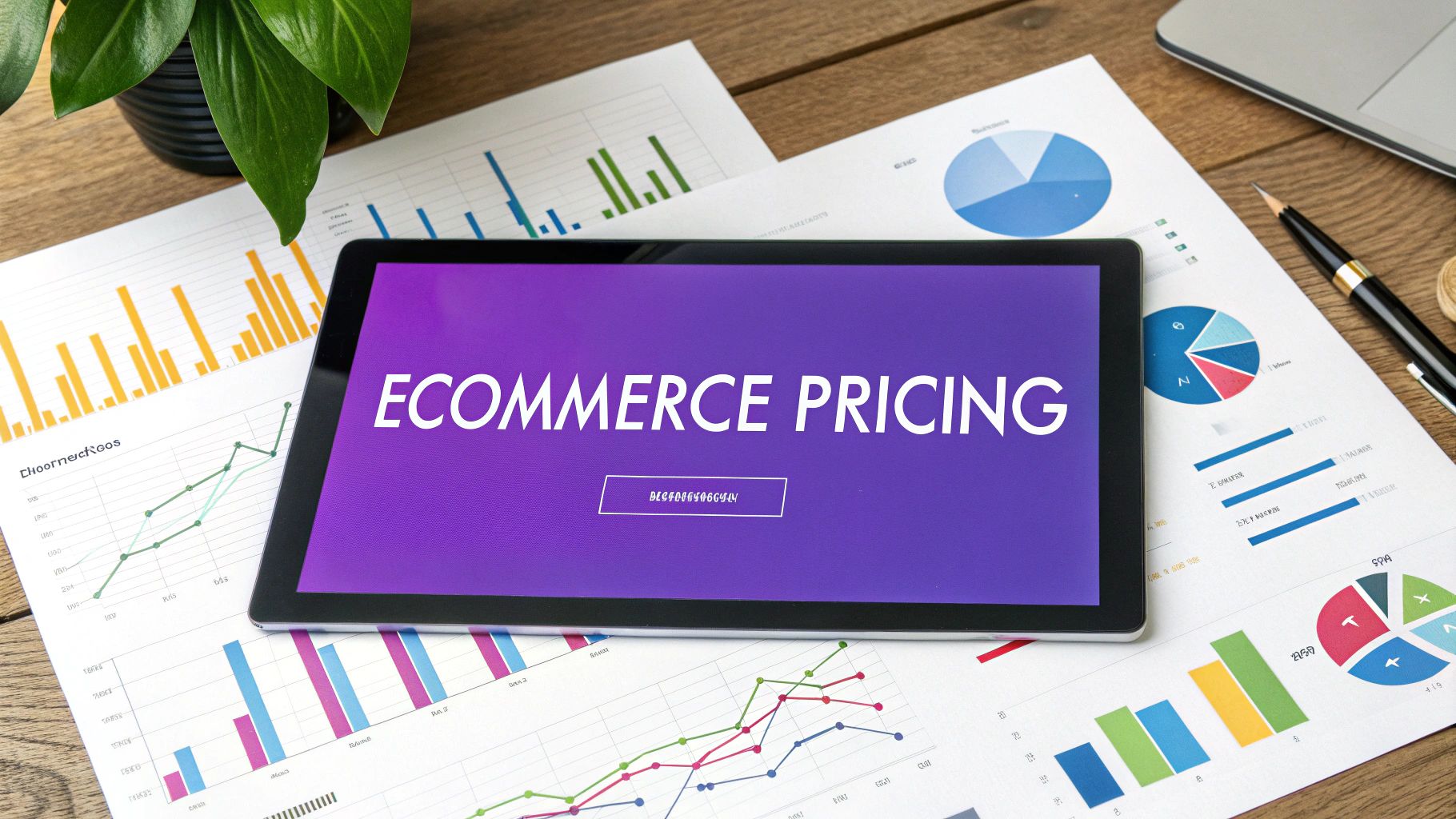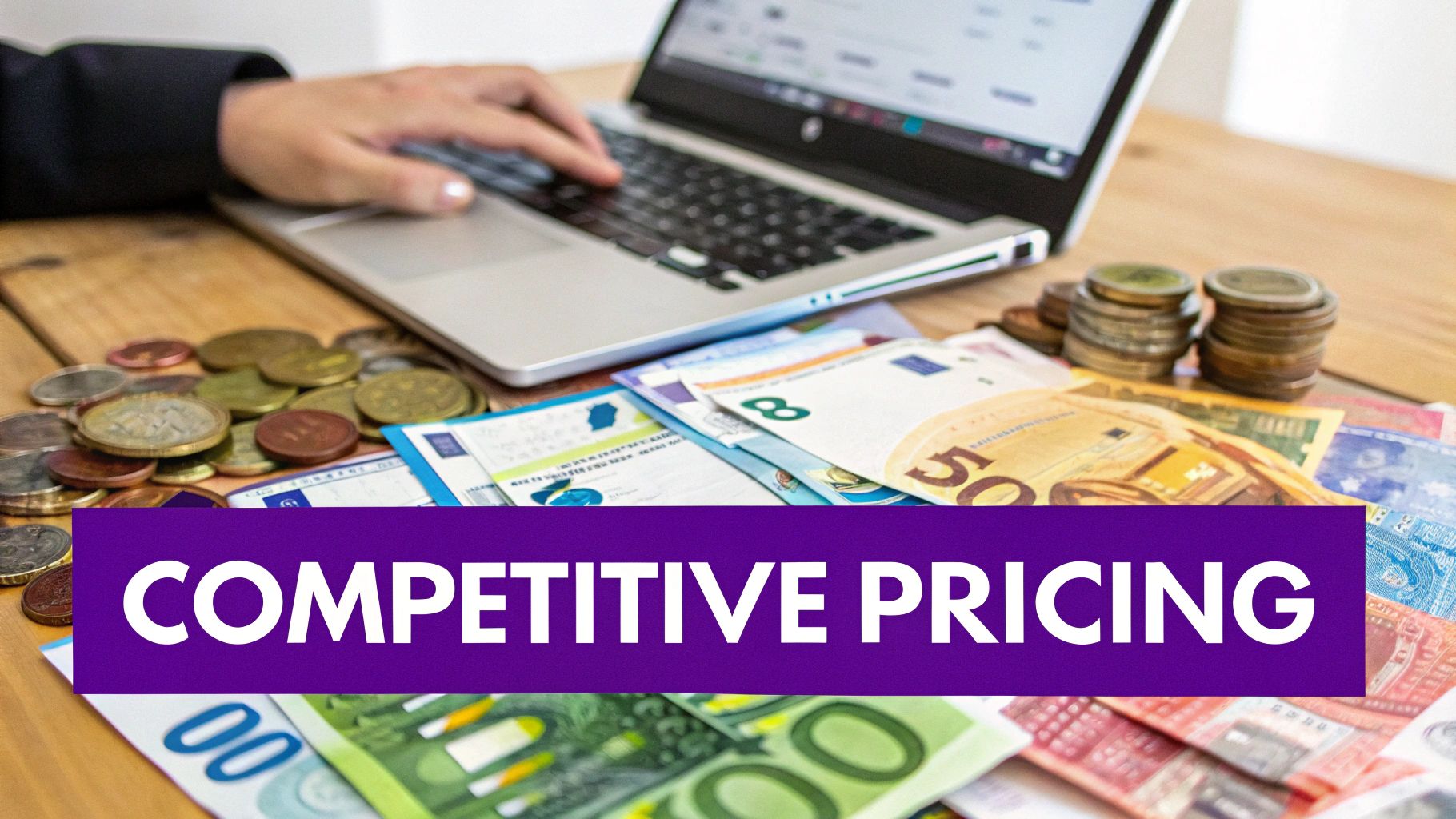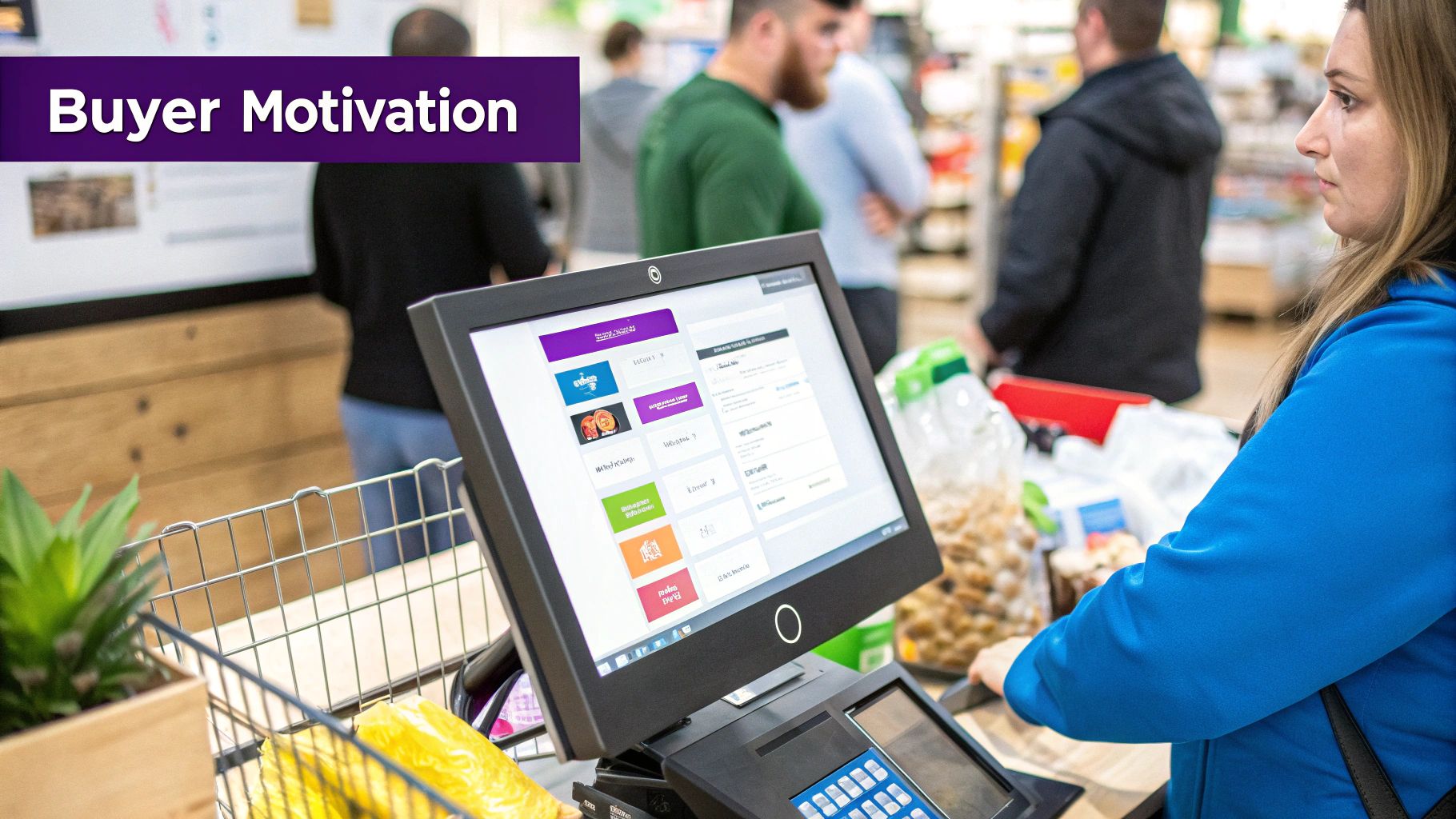Ecommerce Pricing Strategies: The Complete Guide for Online Retailers

Building a Smart Dynamic Pricing Foundation

Want to boost your ecommerce sales? Dynamic pricing could be your secret weapon. This pricing approach lets you adjust prices based on real-world conditions to maximize profits while staying competitive. But success requires more than randomly changing prices - you need a solid foundation built on key principles.
Understanding the Core Components of Dynamic Pricing
Three essential elements work together to create effective dynamic pricing: data, rules, and execution. Let's look at how each piece fits together.
Data forms the base of your pricing strategy. You'll want to collect and analyze information from multiple sources - your past sales records, current inventory status, competitor prices, and broader market patterns. For example, if you notice certain products consistently sell better during holidays, you can plan price adjustments around those peak times.
Next come the rules that determine how prices change in response to your data. Think of these as guardrails that keep pricing changes sensible and profitable. You might set minimum prices to protect margins during price wars, or program automatic increases when stock runs low or demand spikes. Well-designed rules help maintain consistency across your product catalog.
Finally, putting your strategy into action requires the right tools and setup. Selecting appropriate pricing software and connecting it properly with your existing store platform makes the difference between smooth operation and constant headaches.
Choosing the Right Dynamic Pricing Software
When evaluating pricing tools, consider what features really matter for your business. Basic solutions work for simple needs, while larger operations may require advanced capabilities like competitor tracking and AI-powered price optimization. Focus on finding software that matches your specific goals and budget constraints.
Key factors to evaluate include: Is the interface easy to use? Will it integrate smoothly with your current systems? Can you customize pricing rules to fit your unique strategy? Also check that the reporting gives you clear insights to measure and improve results over time.
Balancing Automation with Human Oversight
While automated pricing brings huge benefits, don't remove humans from the equation entirely. Regular review of your pricing rules ensures they still make sense as market conditions change. If a competitor launches a major sale, you may need to temporarily adjust your strategy to stay in the game. This ongoing monitoring and fine-tuning leads to better long-term results.
Building strong dynamic pricing takes careful planning and consistent effort, but the payoff is worth it. When you understand the core elements, choose the right tools, and maintain appropriate human oversight, you can create a pricing approach that boosts revenue while keeping customers happy in today's competitive ecommerce landscape.
Mastering the Art of Competitive Price Analysis

Setting the right prices for your ecommerce business requires a deep understanding of what your competitors are doing. You can't just choose prices randomly - you need real data about market rates and how customers respond to different price points. By learning how to analyze competitor pricing effectively, you can make smart decisions that help your business grow.
Why Competitive Price Analysis Matters
Taking time to study competitor pricing gives you a clear view of where you stand in the marketplace. When you track pricing patterns closely, you can spot opportunities to boost profits, adjust your strategies, and respond thoughtfully to competitor moves. For instance, if you notice a competitor consistently pricing below you on certain items, careful analysis can reveal whether they're accepting smaller margins, have found ways to cut costs, or are using those products as loss leaders to attract customers. Having these insights lets you make strategic choices rather than just reacting blindly to price changes.
Key Metrics to Track
Good competitive analysis means looking at several important factors beyond just the base price. To fully understand the pricing landscape, you need to consider:
- Price Points: Track competitors' prices across your product catalog to understand how yours compare
- Promotional Activities: Keep an eye on sales, discounts and other promotions to anticipate marketing campaigns
- Shipping Costs: Factor in delivery fees since they affect the total price customers pay. Free shipping can set you apart
- Product Bundling: Study how competitors package products together and what discounts they offer on bundles
- Customer Reviews and Ratings: These provide insights into how customers view the value and can guide pricing decisions
Tools and Techniques for Effective Tracking
You have several options for tracking competitor prices, from basic to advanced approaches:
- Manual Research: Regularly check competitor websites and record prices. This works for smaller catalogs but takes time
- Web Scraping Tools: Use automation to gather pricing data from competitor sites quickly and accurately
- Pricing Intelligence Software: Invest in platforms that provide real-time monitoring, alerts and detailed analytics for larger operations
Positioning Your Prices Strategically
Once you understand the competitive landscape, you can position your prices thoughtfully based on your target market, brand identity and business goals:
- Premium Pricing: If you offer unique products or excellent service, you may be able to charge more than competitors. This approach works well for luxury brands
- Competitive Pricing: Matching market rates makes sense for commodity products but requires careful attention to margins
- Value Pricing: Focus on the total package - combine fair prices with added benefits like warranties or great customer service
Remember that pricing isn't a set-it-and-forget-it task. You need to keep monitoring the market and adjusting your approach. By staying informed about what competitors are doing and understanding how customers respond, you can find the right pricing strategy to grow your business sustainably over time. The key is to keep learning and refining your methods based on real market feedback.
Turning Seasonal Trends Into Profit Opportunities

Smart pricing is about more than just matching competitors or making occasional adjustments. The real opportunity lies in understanding and capitalizing on seasonal patterns throughout the year. Rather than simply offering generic holiday discounts, successful ecommerce businesses develop pricing strategies that align with natural demand cycles to boost revenue during peak periods while protecting profits during slower times.
Identifying Key Seasonal Opportunities for Your Ecommerce Business
To create an effective seasonal pricing plan, start by mapping out the key selling periods that matter most for your products. While major holidays like Christmas and Black Friday are obvious choices, don't overlook smaller seasonal opportunities unique to your niche. For example, if you sell school supplies, the back-to-school rush in late summer could be one of your biggest sales periods. Outdoor gear might spike at the start of camping season.
Looking at your past sales data is essential for spotting these patterns. By analyzing year-over-year trends, you may discover consistent spikes in certain product categories that aren't tied to major holidays - like gardening tools selling best in early spring. These insights help you identify profitable seasonal opportunities others might miss.
Building a Seasonal Pricing Calendar and Inventory Strategy
Once you know your key selling periods, create a pricing calendar that outlines planned price changes throughout the year. This might mean gradually increasing prices on winter gear as cold weather approaches, then marking items down at season's end to clear inventory. Having this roadmap helps you stay proactive rather than reactive with pricing.
Smart inventory planning goes hand-in-hand with seasonal pricing. Stocking too much inventory for peak periods can lead to costly markdowns if demand falls short. But having too little means missing sales during your busiest times. Use your historical data to forecast demand and sync inventory purchases with your pricing calendar. Consider factors like lead times and storage costs when planning seasonal stock levels.
Timing Promotions Strategically for Maximum Impact
The timing of seasonal promotions can make or break their success. Start too early and you might lose full-price sales. Wait too long and you'll miss the natural surge in demand. For example, swimwear promotions typically perform best right as summer begins, when shoppers are actively looking for beach gear. Running the same sale a month later likely won't generate the same results.
Your promotional messaging matters too. Rather than just advertising discounts, position sales as limited-time seasonal opportunities. Phrases like "Summer kickoff sale" or "End of season clearance" create more urgency than generic percent-off messaging. This helps drive faster purchase decisions during key seasonal windows.
Optimizing Your Ecommerce Pricing Strategies for Year-Round Success
The most successful seasonal pricing strategies evolve based on results. Track the performance of different promotions and price changes throughout the year. Which seasonal adjustments drove the most sales? Where did inventory levels align well with demand? Use these insights to refine your approach over time.
Remember that seasonal pricing isn't just about maximizing short-term revenue. When done right, it helps build customer loyalty by offering good value at the right times. Shoppers appreciate predictable seasonal sales they can plan around. Focus on creating sustainable pricing strategies that work for both your business and your customers year after year.
Creating Value-Driven Pricing Tiers That Convert

Smart product pricing involves more than basic cost calculations. The real art lies in creating pricing tiers that speak to different types of customers and encourage them to spend more over time. When done right, your pricing structure becomes one of your most powerful tools for growing revenue.
Understanding Your Customer Segments and Their Needs
Success starts with really getting to know your customers. Different buyers have different priorities and budgets - a cost-conscious customer mainly wants core features at a good price, while someone willing to pay more expects premium benefits and white-glove service. By understanding these distinct groups, you can design pricing tiers that naturally appeal to each one.
Designing Pricing Tiers That Offer Clear Value Progression
Each tier should provide a distinct set of capabilities that makes the price difference worthwhile. Think of it like steps on a ladder - as customers move up, they get access to more valuable features and perks. This gives them clear motivation to upgrade.
For example, a software company might start with basic features and limited usage at the entry level, add more capabilities and higher usage limits in the middle tier, and offer unlimited everything plus VIP support at the premium level. This lets customers pick the perfect fit while leaving room to upgrade as their needs grow.
Psychology of Pricing Tiers: Anchoring and Framing
Smart pricing strategies tap into key psychological principles. One is anchoring - showing a premium option makes mid-tier pricing feel more reasonable by comparison. The premium tier acts as a reference point that influences how people view the other choices.
How you present prices also shapes perception. Highlighting the savings on annual vs. monthly plans can nudge people toward longer commitments. Marking certain tiers as "most popular" subtly guides customers toward those options.
Optimizing for Upsells and Cross-Sells Within Your Tiers
A good pricing structure opens natural paths for customers to spend more over time. Build in opportunities for upgrades and add-ons that make sense for each tier. For instance, a coffee subscription service could start with basic monthly coffee delivery, then offer a mid-tier that adds a free mug and discounts, and top it off with a premium plan including exclusive roasts and tasting events.
The key is making these upsells feel helpful rather than pushy. When you truly understand what different customers want, you can suggest relevant upgrades that they'll actually appreciate. Keep gathering feedback and studying your data to continually refine your tiers. Focus on building pricing that drives both immediate sales and lasting customer relationships. The best pricing structures don't just convert - they create loyal fans who stick with you and spend more over time.
Designing High-Impact Promotional Campaigns
Setting the right prices is only part of a successful ecommerce strategy. Thoughtfully planned promotional campaigns play a vital role in driving sales, managing inventory levels, and bringing in new customers. But randomly discounting products can quickly eat into your profits. Let's explore how successful retailers create promotions that boost revenue while protecting their margins, with a focus on proven approaches that connect with shoppers.
Planning Your Promotional Calendar
Just like regular pricing patterns follow seasonal trends, your promotional schedule should align with key selling periods throughout the year. A well-planned promotional calendar helps you engage customers consistently and predict results reliably. Start by mapping out major holidays and shopping events, then add in seasonal periods specific to your products. For example, a store selling beach gear might run promotions for early summer shopping, back-to-school season, and end-of-season clearance. This allows you to manage inventory proactively and craft targeted messaging that resonates.
Strategic Timing for Maximum Impact
Getting the timing right can make or break a promotion's success. Launch too early and you may lose out on full-price sales; too late and you'll miss peak demand. Pay close attention to your customers' typical buying patterns. For instance, if your data shows winter coat sales spike in November, an early October promotion might be premature while waiting until December could mean missing the busiest shopping period. Study the results of past campaigns to fine-tune your promotion timing for the best possible outcomes.
Effective Discount Structures and Promotion Types
The way you structure discounts and the types of promotions you choose can strongly influence how customers respond. While straightforward percentage discounts are popular and easy to understand, other approaches like tiered discounts can encourage larger purchases (e.g., spend $50 for 10% off, $100 for 20% off).
Consider mixing in these proven promotion types:
- Flash Sales: Short-term deep discounts that create excitement and urgency
- Free Shipping: A powerful motivator, especially on higher-priced items
- Bundling: Pairing related products at a special combined price
- Buy-One-Get-One (BOGO): Great for moving inventory while offering clear value
- Contests and Giveaways: Build buzz and strengthen brand connections
Choose promotion types and structures that match your specific goals and target customers.
Measuring and Optimizing Promotion Effectiveness
Running promotions is just the start - you need to track results and adjust your approach based on what works. Focus on these key metrics:
- Conversion Rate: What percentage of promotion viewers make a purchase?
- Average Order Value (AOV): Are promotional orders larger than usual?
- Return on Investment (ROI): Do promotion profits justify the discounts?
- Customer Acquisition Cost (CAC): What's the cost to gain new customers?
Analyzing these numbers helps identify your most effective promotions and shows where adjustments are needed. This data-driven approach ensures your promotional campaigns build profitable growth and strengthen your bottom line while supporting your overall pricing strategy.
Measuring What Matters in Pricing Performance
Smart ecommerce pricing requires more than setting initial prices. Success comes from carefully watching how your prices perform and adjusting them based on what you learn about your market, competitors, and most importantly - your customers. The key is identifying and tracking the metrics that truly show whether your pricing approach is working.
Key Pricing KPIs for Ecommerce Success
While you could track dozens of different metrics, these KPIs give the clearest picture of pricing effectiveness:
Conversion Rate: This shows what percentage of visitors make a purchase. For example, if 1,000 people visit a product page and 50 buy, that's a 5% conversion rate. Low rates often mean prices are too high or customers don't see enough value.
Average Order Value (AOV): This measures how much customers typically spend per order. When AOV goes up, it means people are either buying more items or choosing higher-priced options. Smart bundling and tiered pricing can help boost AOV.
Customer Lifetime Value (CLTV): This estimates how much revenue you'll get from a customer over their entire relationship with your business. Good pricing helps attract and keep loyal customers who spend more over time.
Price Elasticity of Demand: This shows how sensitive your sales are to price changes. If a small price increase causes a big drop in sales, customers are very price-sensitive. Understanding this helps you find the right price points.
Gross Profit Margin: This reveals your actual profit after subtracting product costs. The challenge is setting prices that stay competitive while maintaining healthy margins for growth.
Shopping Cart Abandonment Rate: When lots of people add items but don't buy, it often points to pricing problems, surprise shipping costs, or checkout hassles.
Building Effective Feedback Loops
The real value comes from using this data to guide your pricing decisions. This means regularly checking your metrics, spotting patterns, and adjusting prices when needed.
For example, if sales drop sharply after a price increase, you may need to lower prices or find ways to show more value. Testing different price levels and promotions helps you learn what your target customers respond to best.
Continuous Optimization for Sustainable Growth
Smart pricing requires constant fine-tuning. By watching your key metrics closely and making data-driven adjustments, you can stay competitive and profitable while growing your business for the long term. The key is being flexible and willing to update your pricing as markets, competition and customer preferences change.
Want to grow your ecommerce business? Wand Websites offers expert Shopify store design and optimization to help you succeed. We handle everything from setup to maintenance, so you can focus on your products. Visit https://www.wandwebsites.com to learn more about transforming your online store today.


